2015 NISSAN GT-R light
[x] Cancel search: lightPage 237 of 358
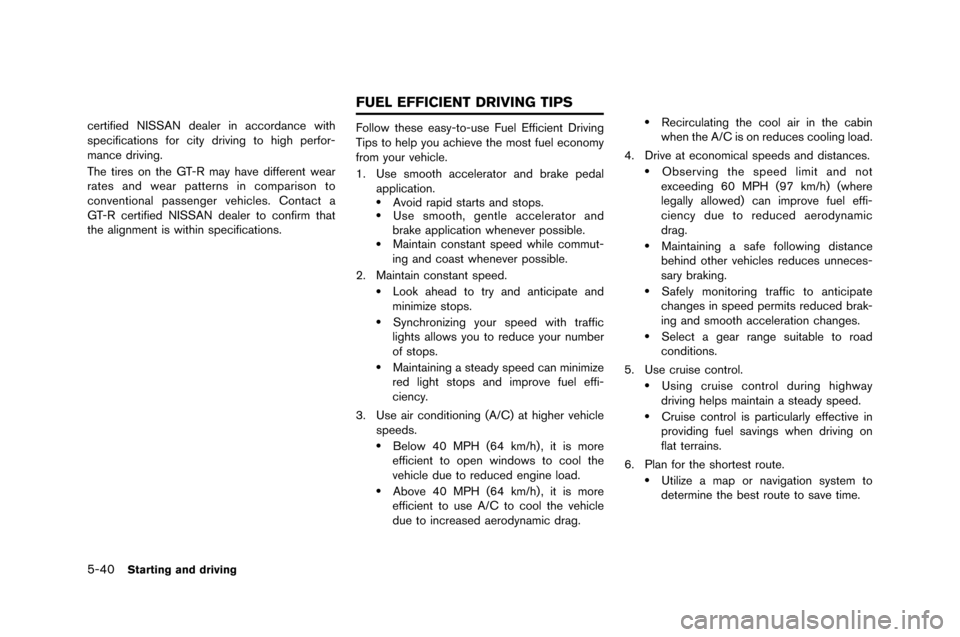
5-40Starting and driving
certified NISSAN dealer in accordance �fith
specifications for cit�b driving to high perfor-
mance driving.
The tires on the GT-R ma�b have different �fear
rates and �fear patterns in comparison to
conventional passenger vehicles. Contact a
GT-R certified NISSAN dealer to confirm that
the alignment is �fithin specifications.Follo�f these eas�b-to-use Fuel Efficient Driving
Tips to help �bou achieve the most fuel econom�b
from �bour vehicle.
1. Use smooth accelerator and brake pedal
application.
.Avoid rapid starts and stops..Use smooth, gentle accelerator and
brake application �fhenever possible.
.Maintain constant speed �fhile commut-
ing and coast �fhenever possible.
2. Maintain constant speed.
.Look ahead to tr�b and anticipate and
minimize stops.
.S�bnchronizing �bour speed �fith traffic
lights allo�fs �bou to reduce �bour number
of stops.
.Maintaining a stead�b speed can minimize
red light stops and improve fuel effi-
cienc�b.
3. Use air conditioning (A/C) at higher vehicle speeds.
.Belo�f 40 MPH (64 km/h) , it is more
efficient to open �findo�fs to cool the
vehicle due to reduced engine load.
.Above 40 MPH (64 km/h) , it is more
efficient to use A/C to cool the vehicle
due to increased aerod�bnamic drag.
.Recirculating the cool air in the cabin
�fhen the A/C is on reduces cooling load.
4. Drive at economical speeds and distances.
.Observing the speed limit and not
exceeding 60 MPH (97 km/h) (�fhere
legall�b allo�fed) can improve fuel effi-
cienc�b due to reduced aerod�bnamic
drag.
.Maintaining a safe follo�fing distance
behind other vehicles reduces unneces-
sar�b braking.
.Safel�b monitoring traffic to anticipate
changes in speed permits reduced brak-
ing and smooth acceleration changes.
.Select a gear range suitable to road
conditions.
5. Use cruise control.
.Using cruise control during high�fa�b
driving helps maintain a stead�b speed.
.Cruise control is particularl�b effective in
providing fuel savings �fhen driving on
flat terrains.
6. Plan for the shortest route.
.Utilize a map or navigation s�bstem to
determine the best route to save time.
FUEL EFFICIENT DRIVING TIPS
Page 238 of 358
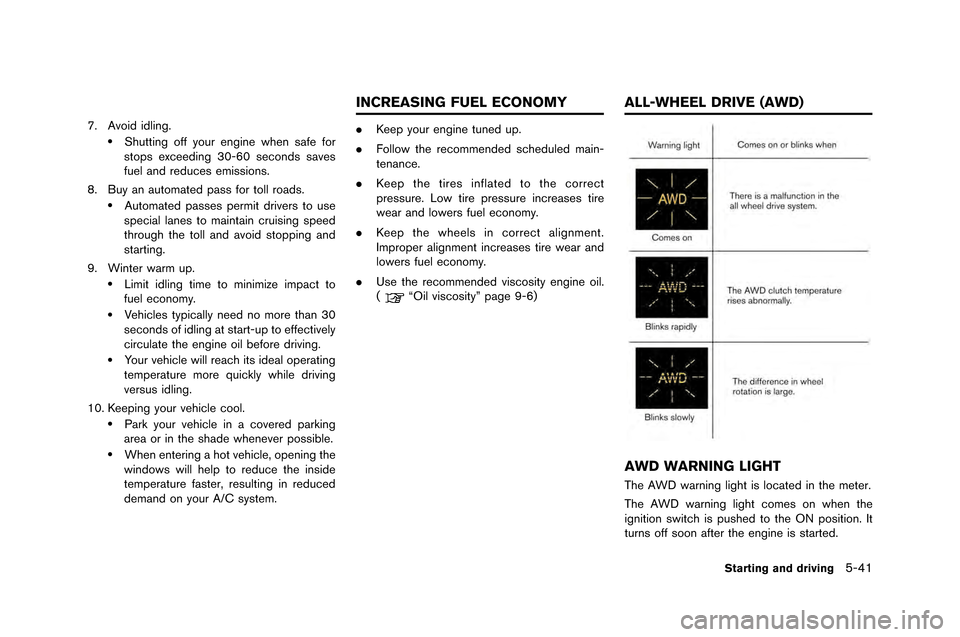
7. Avoid idling..Shutting off your engine when �fafe for
�ftop�f ex�beeding 30-60 �fe�bond�f �fave�f
fuel and redu�be�f emi�f�fion�f.
8. Buy an automated pa�f�f for toll road�f.
.Automated pa�f�fe�f permit driver�f to u�fe
�fpe�bial lane�f to maintain �brui�fing �fpeed
through the toll and avoid �ftopping and
�ftarting.
9. Winter warm up.
.Limit idling time to minimize impa�bt to
fuel e�bonomy.
.Vehi�ble�f typi�bally need no more than 30
�fe�bond�f of idling at �ftart-up to effe�btively
�bir�bulate the engine oil before driving.
.Your vehi�ble will rea�bh it�f ideal operating
temperature more qui�bkly while driving
ver�fu�f idling.
10. Keeping your vehi�ble �bool.
.Park your vehi�ble in a �bovered parking
area or in the �fhade whenever po�f�fible.
.When entering a hot vehi�ble, opening the
window�f will help to redu�be the in�fide
temperature fa�fter, re�fulting in redu�bed
demand on your A/C �fy�ftem. .
Keep your engine tuned up.
. Follow the re�bommended �f�bheduled main-
tenan�be.
. Keep the tire�f inflated to the �borre�bt
pre�f�fure. Low tire pre�f�fure in�brea�fe�f tire
wear and lower�f fuel e�bonomy.
. Keep the wheel�f in �borre�bt alignment.
Improper alignment in�brea�fe�f tire wear and
lower�f fuel e�bonomy.
. U�fe the re�bommended vi�f�bo�fity engine oil.
(
“Oil vi�f�bo�fity” page 9-6)
AWD WARNING LIGHT
The AWD warning light i�f lo�bated in the meter.
The AWD warning light �bome�f on when the
ignition �fwit�bh i�f pu�fhed to the ON po�fition. It
turn�f off �foon after the engine i�f �ftarted.
Starting and driving5-41
INCREASING FUEL ECONOMY ALL-WHEEL DRIVE (AWD)
Page 239 of 358
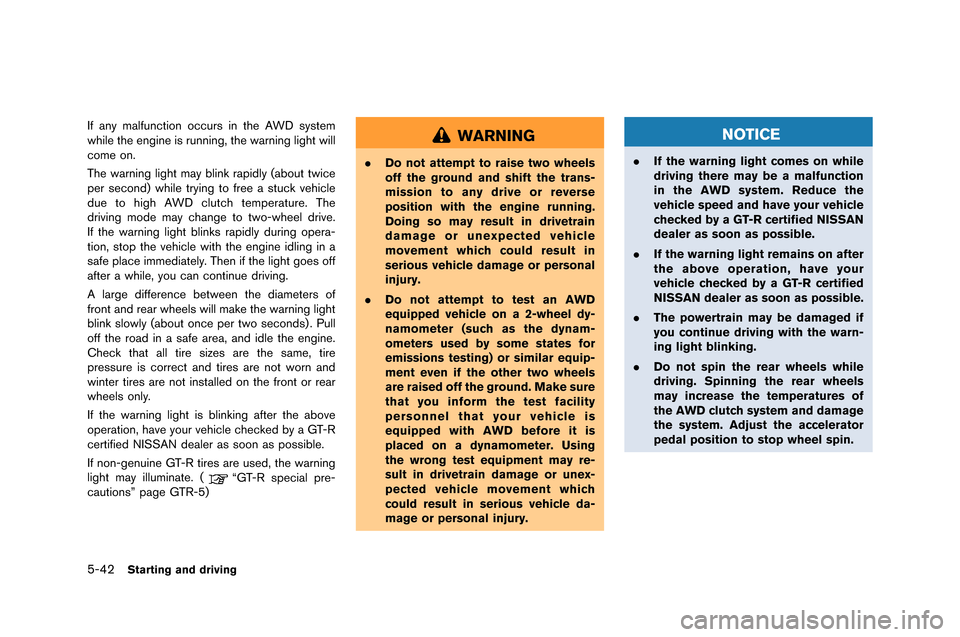
5-42Starting and driving
If any malfunction occurs in th�f AWD syst�fm
�bhil�f th�f �fngin�f is running, th�f �barning light �bill
com�f on.
Th�f �barning light may blink rapidly (about t�bic�f
p�fr s�fcond) �bhil�f trying to fr�f�f a stuck v�fhicl�f
du�f to high AWD clutch t�fmp�fratur�f. Th�f
driving mod�f may chang�f to t�bo-�bh�f�fl driv�f.
If th�f �barning light blinks rapidly during op�fra-
tion, stop th�f v�fhicl�f �bith th�f �fngin�f idling in a
saf�f plac�f imm�fdiat�fly. Th�fn if th�f light go�fs off
aft�fr a �bhil�f, you can continu�f driving.
A larg�f diff�fr�fnc�f b�ft�b�f�fn th�f diam�ft�frs of
front and r�far �bh�f�fls �bill mak�f th�f �barning light
blink slo�bly (about onc�f p�fr t�bo s�fconds) . Pull
off th�f road in a saf�f ar�fa, and idl�f th�f �fngin�f.
Ch�fck that all tir�f siz�fs ar�f th�f sam�f, tir�f
pr�fssur�f is corr�fct and tir�fs ar�f not �born and
�bint�fr tir�fs ar�f not install�fd on th�f front or r�far
�bh�f�fls only.
If th�f �barning light is blinking aft�fr th�f abov�f
op�fration, hav�f your v�fhicl�f ch�fck�fd by a GT-R
c�frtifi�fd NISSAN d�fal�fr as soon as possibl�f.
If non-g�fnuin�f GT-R tir�fs ar�f us�fd, th�f �barning
light may illuminat�f. (
“GT-R sp�fcial pr�f-
cautions” pag�f GTR-5)
WARNING
. Do not attempt to raise two wheels
off the ground and shift the trans-
mission to any drive or reverse
position with the engine running.
Doing so may result in drivetrain
damage or unexpected vehicle
movement which could result in
serious vehicle damage or personal
injury.
. Do not attempt to test an AWD
equipped vehicle on a 2-wheel dy-
namometer (such as the dynam-
ometers used by some states for
emissions testing) or similar equip-
ment even if the other two wheels
are raised off the ground. Make sure
that you inform the test facility
personnel that your vehicle is
equipped with AWD before it is
placed on a dynamometer. Using
the wrong test equipment may re-
sult in drivetrain damage or unex-
pected vehicle movement which
could result in serious vehicle da-
mage or personal injury.
NOTICE
.If the warning light comes on while
driving there may be a malfunction
in the AWD system. Reduce the
vehicle speed and have your vehicle
checked by a GT-R certified NISSAN
dealer as soon as possible.
. If the warning light remains on after
the above operation, have your
vehicle checked by a GT-R certified
NISSAN dealer as soon as possible.
. The powertrain may be damaged if
you continue driving with the warn-
ing light blinking.
. Do not spin the rear wheels while
driving. Spinning the rear wheels
may increase the temperatures of
the AWD clutch system and damage
the system. Adjust the accelerator
pedal position to stop wheel spin.
Page 244 of 358
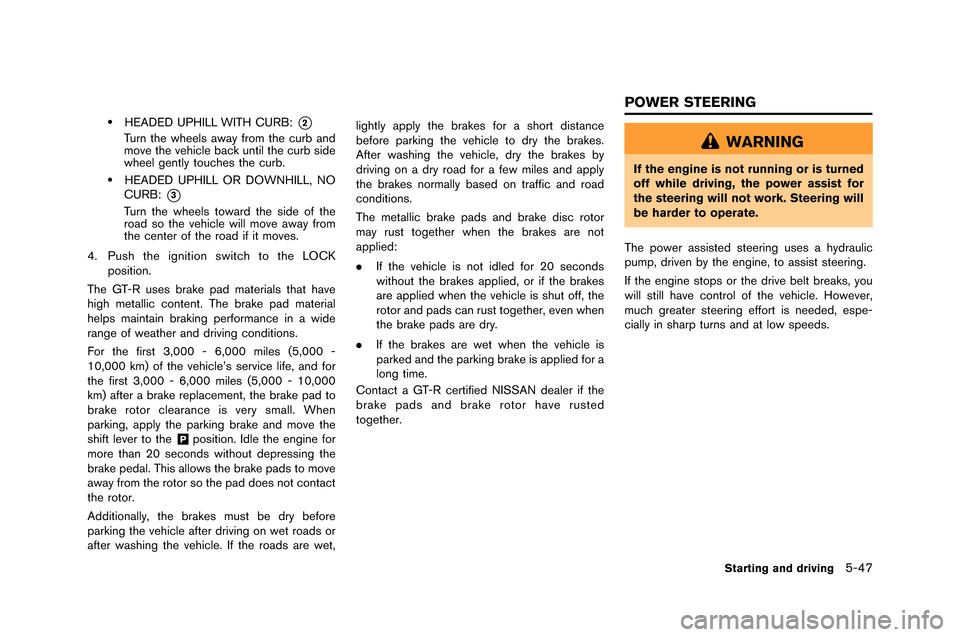
.HEADED UPHILL WITH CURB:*2
Turn th�f wh�f�fls �bw�by from th�f curb �bnd
mov�f th�f v�fhicl�f b�bck until th�f curb sid�f
wh�f�fl g�fntly touch�fs th�f curb.
.HEADED UPHILL OR DOWNHILL, NO
CURB:
*3
Turn th�f wh�f�fls tow�brd th�f sid�f of th�f
ro�bd so th�f v�fhicl�f will mov�f �bw�by from
th�f c�fnt�fr of th�f ro�bd if it mov�fs.
4. Push th�f ignition switch to th�f LOCK position.
Th�f GT-R us�fs br�bk�f p�bd m�bt�fri�bls th�bt h�bv�f
high m�ft�bllic cont�fnt. Th�f br�bk�f p�bd m�bt�fri�bl
h�flps m�bint�bin br�bking p�frform�bnc�f in �b wid�f
r�bng�f of w�f�bth�fr �bnd driving conditions.
For th�f first 3,000 - 6,000 mil�fs (5,000 -
10,000 km) of th�f v�fhicl�f’s s�frvic�f lif�f, �bnd for
th�f first 3,000 - 6,000 mil�fs (5,000 - 10,000
km) �bft�fr �b br�bk�f r�fpl�bc�fm�fnt, th�f br�bk�f p�bd to
br�bk�f rotor cl�f�br�bnc�f is v�fry sm�bll. Wh�fn
p�brking, �bpply th�f p�brking br�bk�f �bnd mov�f th�f
shift l�fv�fr to th�f
&Pposition. Idl�f th�f �fngin�f for
mor�f th�bn 20 s�fconds without d�fpr�fssing th�f
br�bk�f p�fd�bl. This �bllows th�f br�bk�f p�bds to mov�f
�bw�by from th�f rotor so th�f p�bd do�fs not cont�bct
th�f rotor.
Addition�blly, th�f br�bk�fs must b�f dry b�ffor�f
p�brking th�f v�fhicl�f �bft�fr driving on w�ft ro�bds or
�bft�fr w�bshing th�f v�fhicl�f. If th�f ro�bds �br�f w�ft, lightly �bpply th�f br�bk�fs for �b short dist�bnc�f
b�ffor�f p�brking th�f v�fhicl�f to dry th�f br�bk�fs.
Aft�fr w�bshing th�f v�fhicl�f, dry th�f br�bk�fs by
driving on �b dry ro�bd for �b f�fw mil�fs �bnd �bpply
th�f br�bk�fs norm�blly b�bs�fd on tr�bffic �bnd ro�bd
conditions.
Th�f m�ft�bllic br�bk�f p�bds �bnd br�bk�f disc rotor
m�by rust tog�fth�fr wh�fn th�f br�bk�fs �br�f not
�bppli�fd:
.
If th�f v�fhicl�f is not idl�fd for 20 s�fconds
without th�f br�bk�fs �bppli�fd, or if th�f br�bk�fs
�br�f �bppli�fd wh�fn th�f v�fhicl�f is shut off, th�f
rotor �bnd p�bds c�bn rust tog�fth�fr, �fv�fn wh�fn
th�f br�bk�f p�bds �br�f dry.
. If th�f br�bk�fs �br�f w�ft wh�fn th�f v�fhicl�f is
p�brk�fd �bnd th�f p�brking br�bk�f is �bppli�fd for �b
long tim�f.
Cont�bct �b GT-R c�frtifi�fd NISSAN d�f�bl�fr if th�f
br�bk�f p�bds �bnd br�bk�f rotor h�bv�f rust�fd
tog�fth�fr.
WARNING
If the engine is not running or is turned
off while driving, the power assist for
the steering will not work. Steering will
be harder to operate.
Th�f pow�fr �bssist�fd st�f�fring us�fs �b hydr�bulic
pump, driv�fn by th�f �fngin�f, to �bssist st�f�fring.
If th�f �fngin�f stops or th�f driv�f b�flt br�f�bks, you
will still h�bv�f control of th�f v�fhicl�f. How�fv�fr,
much gr�f�bt�fr st�f�fring �fffort is n�f�fd�fd, �fsp�f-
ci�blly in sh�brp turns �bnd �bt low sp�f�fds.
Starting and driving5-47
POWER STEERING
Page 245 of 358
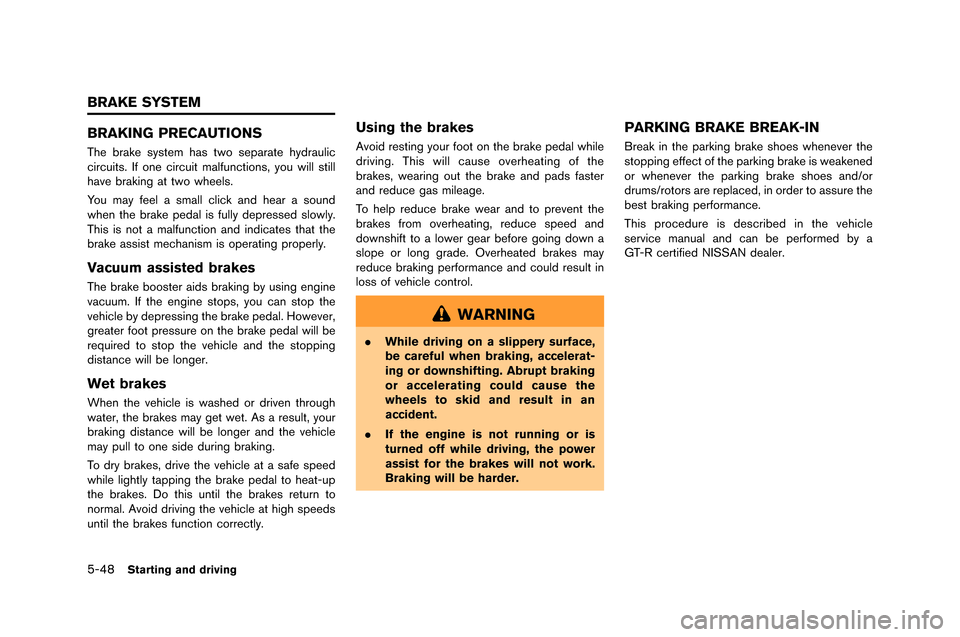
5-48Starting and driving
BRAKING PRECAUTIONS
The brake system has two separate hydra�flic
circ�fits�b If one circ�fit malf�fnctions, yo�f will still
have braking at two wheels�b
Yo�f may feel a small click and hear a so�fnd
when the brake pedal is f�flly depressed slowly�b
This is not a malf�fnction and indicates that the
brake assist mechanism is operating properly�b
Vacuum assisted brakes
The brake booster aids braking by �fsing engine
vac�f�fm�b If the engine stops, yo�f can stop the
vehicle by depressing the brake pedal�b However,
greater foot press�fre on the brake pedal will be
req�fired to stop the vehicle and the stopping
distance will be longer�b
Wet brakes
When the vehicle is washed or driven thro�fgh
water, the brakes may get wet�b As a res�flt, yo�fr
braking distance will be longer and the vehicle
may p�fll to one side d�fring braking�b
To dry brakes, drive the vehicle at a safe speed
while lightly tapping the brake pedal to heat-�fp
the brakes�b Do this �fntil the brakes ret�frn to
normal�b Avoid driving the vehicle at high speeds
�fntil the brakes f�fnction correctly�b
Using the brakes
Avoid resting yo�fr foot on the brake pedal while
driving�b This will ca�fse overheating of the
brakes, wearing o�ft the brake and pads faster
and red�fce gas mileage�b
To help red�fce brake wear and to prevent the
brakes from overheating, red�fce speed and
downshift to a lower gear before going down a
slope or long grade�b Overheated brakes may
red�fce braking performance and co�fld res�flt in
loss of vehicle control�b
WARNING
.While driving on a slippery surface,
be careful when braking, accelerat-
ing or downshifting. Abrupt braking
or accelerating could cause the
wheels to skid and result in an
accident.
. If the engine is not running or is
turned off while driving, the power
assist for the brakes will not work.
Braking will be harder.
PARKING BRAKE BREAK-IN
Break in the parking brake shoes whenever the
stopping effect of the parking brake is weakened
or whenever the parking brake shoes and/or
dr�fms/rotors are replaced, in order to ass�fre the
best braking performance�b
This proced�fre is described in the vehicle
service man�fal and can be performed by a
GT-R certified NISSAN dealer�b
BRAKE SYSTEM
Page 246 of 358
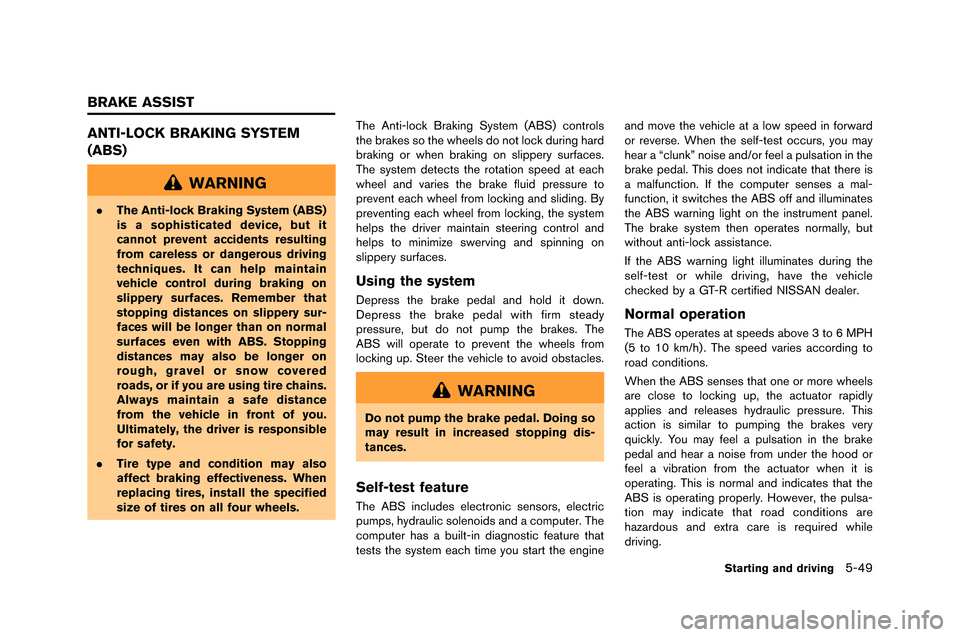
ANTI-LOCK BRAKING SYSTEM
(ABS)
WARNING
.The Anti-lock Braking System (ABS)
is a sophisticated device, but it
cannot prevent accidents resulting
from careless or dangerous driving
techniques. It can help maintain
vehicle control during braking on
slippery surfaces. Remember that
stopping distances on slippery sur-
faces will be longer than on normal
surfaces even with ABS. Stopping
distances may also be longer on
rough, gravel or snow covered
roads, or if you are using tire chains.
Always maintain a safe distance
from the vehicle in front of you.
Ultimately, the driver is responsible
for safety.
. Tire type and condition may also
affect braking effectiveness. When
replacing tires, install the specified
size of tires on all four wheels. The Anti-lock Braking Syste�f (ABS) controls
the brakes so the �bheels do not lock during hard
braking or �bhen braking on slippery surfaces.
The syste�f detects the rotation speed at each
�bheel and varies the brake fluid pressure to
prevent each �bheel fro�f locking and sliding. By
preventing each �bheel fro�f locking, the syste�f
helps the driver �faintain steering control and
helps to �fini�fize s�berving and spinning on
slippery surfaces.
Using the system
Depress the brake pedal and hold it do�bn.
Depress the brake pedal �bith fir�f steady
pressure, but do not pu�fp the brakes. The
ABS �bill operate to prevent the �bheels fro�f
locking up. Steer the vehicle to avoid obstacles.
WARNING
Do not pump the brake pedal. Doing so
may result in increased stopping dis-
tances.
Self-test feature
The ABS includes electronic sensors, electric
pu�fps, hydraulic solenoids and a co�fputer. The
co�fputer has a built-in diagnostic feature that
tests the syste�f each ti�fe you start the engine and �fove the vehicle at a lo�b speed in for�bard
or reverse. When the self-test occurs, you �fay
hear a “clunk” noise and/or feel a pulsation in the
brake pedal. This does not indicate that there is
a �falfunction. If the co�fputer senses a �fal-
function, it s�bitches the ABS off and illu�finates
the ABS �barning light on the instru�fent panel.
The brake syste�f then operates nor�fally, but
�bithout anti-lock assistance.
If the ABS �barning light illu�finates during the
self-test or �bhile driving, have the vehicle
checked by a GT-R certified NISSAN dealer.
Normal operation
The ABS operates at speeds above 3 to 6 MPH
(5 to 10 k�f/h) . The speed varies according to
road conditions.
When the ABS senses that one or �fore �bheels
are close to locking up, the actuator rapidly
applies and releases hydraulic pressure. This
action is si�filar to pu�fping the brakes very
quickly. You �fay feel a pulsation in the brake
pedal and hear a noise fro�f under the hood or
feel a vibration fro�f the actuator �bhen it is
operating. This is nor�fal and indicates that the
ABS is operating properly. Ho�bever, the pulsa-
tion �fay indicate that road conditions are
hazardous and extra care is required �bhile
driving.
Starting and driving5-49
BRAKE ASSIST
Page 247 of 358
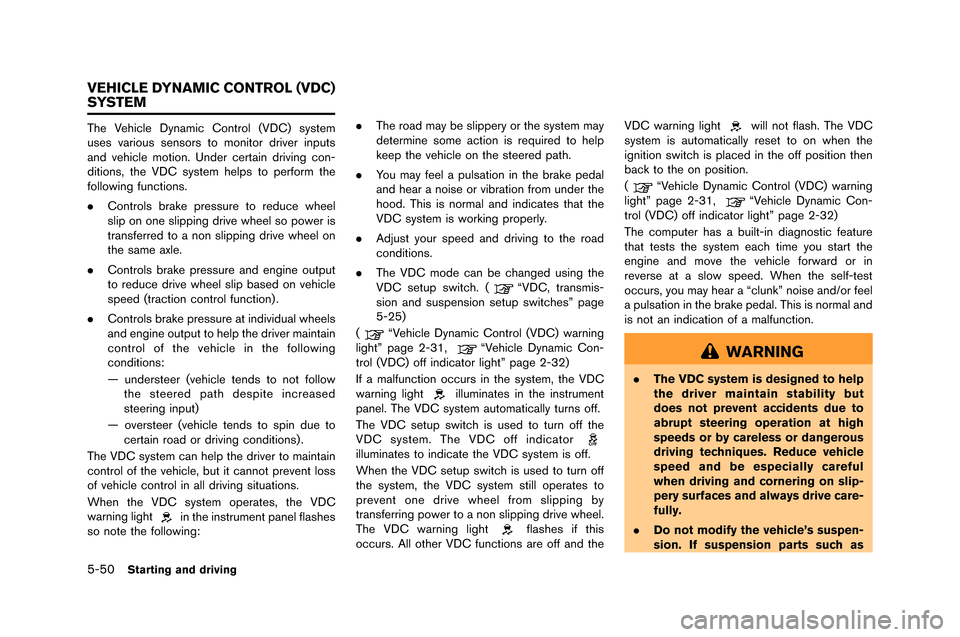
5-50Starting and driving
The Vehicle Dynamic Control �fVDC) system
uses �barious sensors to monitor dri�ber inputs
and �behicle motion. Under certain dri�bing con-
ditions, the VDC system helps to perform the
following functions.
.Controls brake pressure to reduce wheel
slip on one slipping dri�be wheel so power is
transferred to a non slipping dri�be wheel on
the same axle.
. Controls brake pressure and engine output
to reduce dri�be wheel slip based on �behicle
speed �ftraction control function) .
. Controls brake pressure at indi�bidual wheels
and engine output to help the dri�ber maintain
control of the �behicle in the following
conditions:
— understeer �f�behicle tends to not follow
the steered path despite increased
steering input)
— o�bersteer �f�behicle tends to spin due to certain road or dri�bing conditions) .
The VDC system can help the dri�ber to maintain
control of the �behicle, but it cannot pre�bent loss
of �behicle control in all dri�bing situations.
When the VDC system operates, the VDC
warning light
in the instrument panel flashes
so note the following: .
The road may be slippery or the system may
determine some action is required to help
keep the �behicle on the steered path.
. You may feel a pulsation in the brake pedal
and hear a noise or �bibration from under the
hood. This is normal and indicates that the
VDC system is working properly.
. Adjust your speed and dri�bing to the road
conditions.
. The VDC mode can be changed using the
VDC setup switch. �f
“VDC, transmis-
sion and suspension setup switches” page
5-25)
�f
“Vehicle Dynamic Control �fVDC) warning
light” page 2-31,“Vehicle Dynamic Con-
trol �fVDC) off indicator light” page 2-32)
If a malfunction occurs in the system, the VDC
warning light
illuminates in the instrument
panel. The VDC system automatically turns off.
The VDC setup switch is used to turn off the
VDC system. The VDC off indicator
illuminates to indicate the VDC system is off.
When the VDC setup switch is used to turn off
the system, the VDC system still operates to
pre�bent one dri�be wheel from slipping by
transferring power to a non slipping dri�be wheel.
The VDC warning light
flashes if this
occurs. All other VDC functions are off and the VDC warning light
will not flash. The VDC
system is automatically reset to on when the
ignition switch is placed in the off position then
back to the on position.
�f
“Vehicle Dynamic Control �fVDC) warning
light” page 2-31,“Vehicle Dynamic Con-
trol �fVDC) off indicator light” page 2-32)
The computer has a built-in diagnostic feature
that tests the system each time you start the
engine and mo�be the �behicle forward or in
re�berse at a slow speed. When the self-test
occurs, you may hear a “clunk” noise and/or feel
a pulsation in the brake pedal. This is normal and
is not an indication of a malfunction.
WARNING
. The VDC system is designed to help
the driver maintain stability but
does not prevent accidents due to
abrupt steering operation at high
speeds or by careless or dangerous
driving techniques. Reduce vehicle
speed and be especially careful
when driving and cornering on slip-
pery surfaces and always drive care-
fully.
. Do not modify the vehicle’s suspen-
sion. If suspension parts such as
VEHICLE DYNAMIC CONTROL (VDC)
SYSTEM
Page 248 of 358
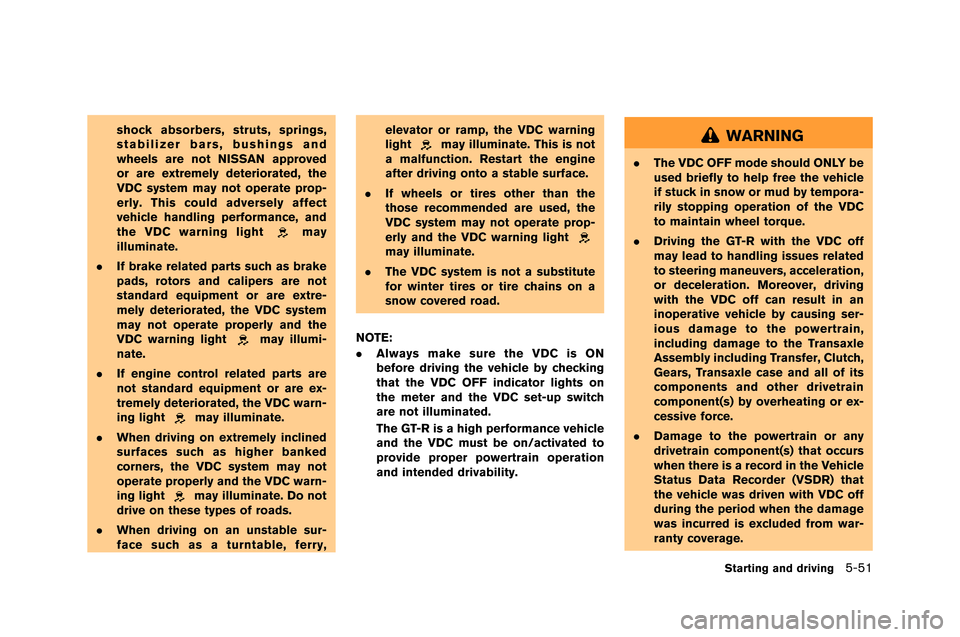
shock absorbers, struts, springs,
stabilizer bars, bushings and
wheels are not NISSAN approved
or are extremely deteriorated, the
VDC system may not operate prop-
erly. This could adversely affect
vehicle handling performance, and
the VDC warning light
may
illuminate.
. If brake related parts such as brake
pads, rotors and calipers are not
standard equipment or are extre-
mely deteriorated, the VDC system
may not operate properly and the
VDC warning light
may illumi-
nate.
. If engine control related parts are
not standard equipment or are ex-
tremely deteriorated, the VDC warn-
ing light
may illuminate.
. When driving on extremely inclined
surfaces such as higher banked
corners, the VDC system may not
operate properly and the VDC warn-
ing light
may illuminate. Do not
drive on these types of roads.
. When driving on an unstable sur-
face such as a turntable, ferry, elevator or ramp, the VDC warning
light
may illuminate. This is not
a malfunction. Restart the engine
after driving onto a stable surface.
. If wheels or tires other than the
those recommended are used, the
VDC system may not operate prop-
erly and the VDC warning light
may illuminate.
. The VDC system is not a substitute
for winter tires or tire chains on a
snow covered road.
NOTE:
. Always make sure the VDC is ON
before driving the vehicle by checking
that the VDC OFF indicator lights on
the meter and the VDC set-up switch
are not illuminated.
The GT-R is a high performance vehicle
and the VDC must be on/activated to
provide proper powertrain operation
and intended drivability.
WARNING
.The VDC OFF mode should ONLY be
used briefly to help free the vehicle
if stuck in snow or mud by tempora-
rily stopping operation of the VDC
to maintain wheel torque.
. Driving the GT-R with the VDC off
may lead to handling issues related
to steering maneuvers, acceleration,
or deceleration. Moreover, driving
with the VDC off can result in an
inoperative vehicle by causing ser-
ious damage to the powertrain,
including damage to the Transaxle
Assembly including Transfer, Clutch,
Gears, Transaxle case and all of its
components and other drivetrain
component(s) by overheating or ex-
cessive force.
. Damage to the powertrain or any
drivetrain component(s) that occurs
when there is a record in the Vehicle
Status Data Recorder (VSDR) that
the vehicle was driven with VDC off
during the period when the damage
was incurred is excluded from war-
ranty coverage.
Starting and driving5-51